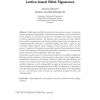Free Online Productivity Tools
i2Speak
i2Symbol
i2OCR
iTex2Img
iWeb2Print
iWeb2Shot
i2Type
iPdf2Split
iPdf2Merge
i2Bopomofo
i2Arabic
i2Style
i2Image
i2PDF
iLatex2Rtf
Sci2ools
ASIACRYPT
2010
Springer
2010
Springer
Lattice-Based Blind Signatures
Blind signatures (BS), introduced by Chaum, have become a cornerstone in privacy-oriented cryptography. Using hard lattice problems, such as the shortest vector problem, as the basis of security has advantages over using the factoring or discrete logarithm problems. For instance, lattice operations are more efficient than modular exponentiation and lattice problems remain hard for quantum and subexponential-time adversaries. Generally speaking, BS allow a signer to sign a message without seeing it, while retaining a certain amount of control over the process. In particular, the signer can control the number of issued signatures. For the receiver of the signature, this process provides perfect anonymity, e.g., his spendings remain anonymous when using BS for electronic money. We provide a positive answer to the question of whether it is possible to implement BS based on lattice problems. More precisely, we show how to turn Lyubashevsky's identification scheme into a BS scheme, whic...
| Added | 10 Feb 2011 |
| Updated | 10 Feb 2011 |
| Type | Journal |
| Year | 2010 |
| Where | ASIACRYPT |
| Authors | Markus Rückert |
Comments (0)

